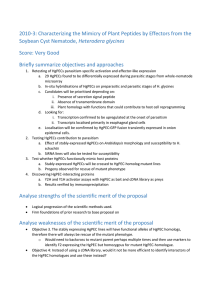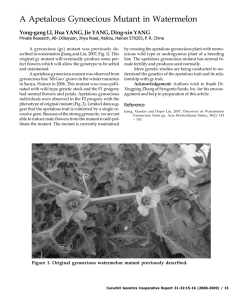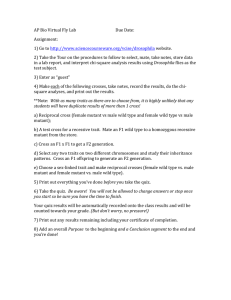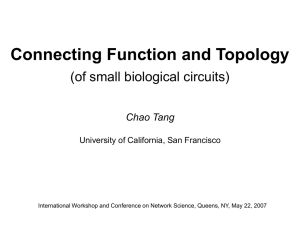A New Dwarf Mutant dw-4 in Watermelon
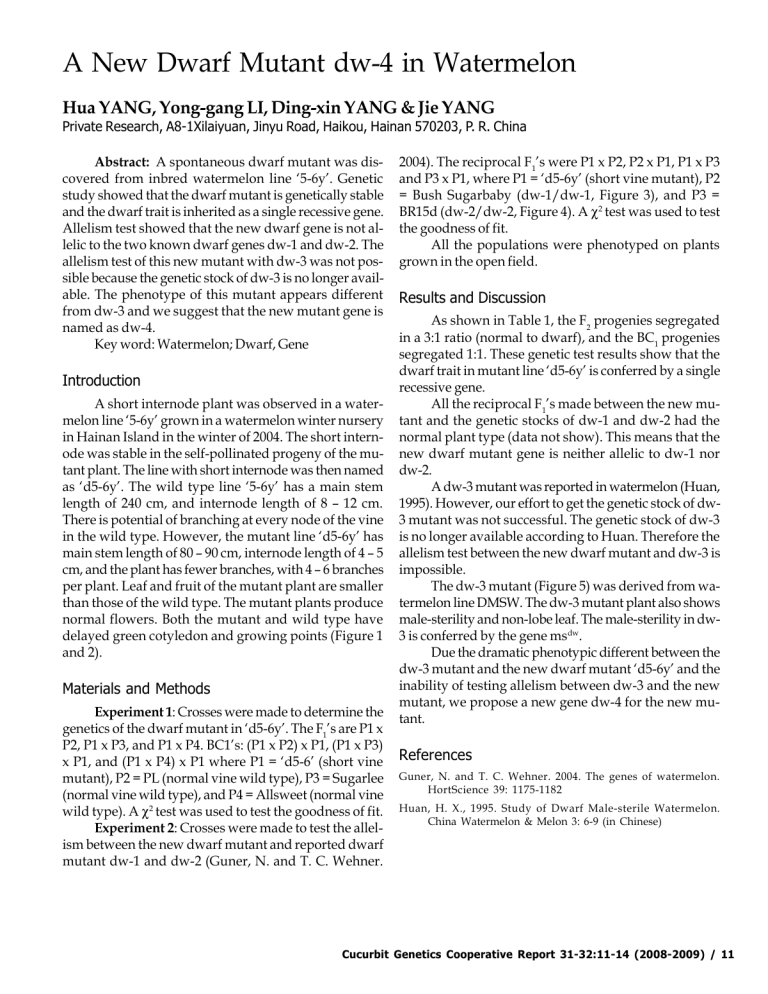
A New Dwarf Mutant dw-4 in Watermelon
Hua YANG, Yong-gang LI, Ding-xin YANG & Jie YANG
Private Research, A8-1Xilaiyuan, Jinyu Road, Haikou, Hainan 570203, P. R. China
Abstract: A spontaneous dwarf mutant was discovered from inbred watermelon line ‘5-6y’. Genetic study showed that the dwarf mutant is genetically stable and the dwarf trait is inherited as a single recessive gene.
Allelism test showed that the new dwarf gene is not allelic to the two known dwarf genes dw-1 and dw-2. The allelism test of this new mutant with dw-3 was not possible because the genetic stock of dw-3 is no longer available. The phenotype of this mutant appears different from dw-3 and we suggest that the new mutant gene is named as dw-4.
Key word: Watermelon; Dwarf, Gene
Introduction
A short internode plant was observed in a watermelon line ‘5-6y’ grown in a watermelon winter nursery in Hainan Island in the winter of 2004. The short internode was stable in the self-pollinated progeny of the mutant plant. The line with short internode was then named as ‘d5-6y’. The wild type line ‘5-6y’ has a main stem length of 240 cm, and internode length of 8 – 12 cm.
There is potential of branching at every node of the vine in the wild type. However, the mutant line ‘d5-6y’ has main stem length of 80 – 90 cm, internode length of 4 – 5 cm, and the plant has fewer branches, with 4 – 6 branches per plant. Leaf and fruit of the mutant plant are smaller than those of the wild type. The mutant plants produce normal flowers. Both the mutant and wild type have delayed green cotyledon and growing points (Figure 1 and 2).
Materials and Methods
Experiment 1 : Crosses were made to determine the genetics of the dwarf mutant in ‘d5-6y’. The F
1
’s are P1 x
P2, P1 x P3, and P1 x P4. BC1’s: (P1 x P2) x P1, (P1 x P3) x P1, and (P1 x P4) x P1 where P1 = ‘d5-6’ (short vine mutant), P2 = PL (normal vine wild type), P3 = Sugarlee
(normal vine wild type), and P4 = Allsweet (normal vine wild type). A χ 2 test was used to test the goodness of fit.
Experiment 2 : Crosses were made to test the allelism between the new dwarf mutant and reported dwarf mutant dw-1 and dw-2 (Guner, N. and T. C. Wehner.
2004). The reciprocal F
1
’s were P1 x P2, P2 x P1, P1 x P3 and P3 x P1, where P1 = ‘d5-6y’ (short vine mutant), P2
= Bush Sugarbaby (dw-1/dw-1, Figure 3), and P3 =
BR15d (dw-2/dw-2, Figure 4). A χ 2 test was used to test the goodness of fit.
All the populations were phenotyped on plants grown in the open field.
Results and Discussion
As shown in Table 1, the F
2
progenies segregated in a 3:1 ratio (normal to dwarf), and the BC
1
progenies segregated 1:1. These genetic test results show that the dwarf trait in mutant line ‘d5-6y’ is conferred by a single recessive gene.
All the reciprocal F
1
’s made between the new mutant and the genetic stocks of dw-1 and dw-2 had the normal plant type (data not show). This means that the new dwarf mutant gene is neither allelic to dw-1 nor dw-2.
A dw-3 mutant was reported in watermelon (Huan,
1995). However, our effort to get the genetic stock of dw-
3 mutant was not successful. The genetic stock of dw-3 is no longer available according to Huan. Therefore the allelism test between the new dwarf mutant and dw-3 is impossible.
The dw-3 mutant (Figure 5) was derived from watermelon line DMSW. The dw-3 mutant plant also shows male-sterility and non-lobe leaf. The male-sterility in dw-
3 is conferred by the gene ms dw .
Due the dramatic phenotypic different between the dw-3 mutant and the new dwarf mutant ‘d5-6y’ and the inability of testing allelism between dw-3 and the new mutant, we propose a new gene dw-4 for the new mutant.
References
Guner, N. and T. C. Wehner. 2004. The genes of watermelon.
HortScience 39: 1175-1182
Huan, H. X., 1995. Study of Dwarf Male-sterile Watermelon.
China Watermelon & Melon 3: 6-9 (in Chinese)
Cucurbit Genetics Cooperative Report 31-32:11-14 (2008-2009) / 11
Table 1. Segregation of F
2
and BC
1
Line ‘d5-6y’ and the Wild Type Lines
Progenies Derived from the Mutant
Cross Generation d5-6y X PL-1 d5-6y X PL-2 d5-6y X PL-3 d5-6y X PL-4 d5-6y X PL-5
PL X d5-6y-1
PL X d5-6y-2 d5-6y X Sugarlee-1 d5-6y X Sugarlee-2 d5-6y X Sugarlee-3
Sugarlee X 5-6y-1 d5-6y X Allsweet
Allsweet X d5-6y
F
F
F
2
2
2
(d5-6y X PL) X d5-6y BC
(d5-6y X PL) X d5-6y BC
(d5-6y X PL) X d5-6y BC
1
1
1
(d5-6y X PL) X d5-6y BC
1
X 2
0.01(df=1)
=6.635 X 2
0.05(df=1)
=3.841
F
F
2
2
F
2
F
F
F
F
2
F
2
2
2
F
2
F
2
2
Total
Plants
Dwarf
Plants
Normal
Plants
516 137 379
509 127 382
610 155 455
172 41
277 77
233 54
253 62
276 67
366 83
490 111 379
131
200
179
191
209
283
425 89
346 93
336
253
539 146 393
322 177 155
250 121 129
300 157 143
162 73 89
Dwarf/Normal X 2 -value
1:2.77
1:3.01
1:2.94
1:3.20
1:2.60
1:3.31
1:3.08
1:3.12
1:3.41
1:3.41
1:3.78
1:2.72
1:2.69
1:0.88
1:1.07
1:0.91
1:1.22
0.6615
0.0007
0.0546
0.1240
1.1564
0.4134
0.0329
0.0773
1.0528
1.4395
3.7341
0.6513
1.2523
1.8137
0.2560
0.6533
1.5802
Figure 1. Plant phenotype of the new mutant (dw-4, top plant) and the wild type (bottom plant).
12 / Cucurbit Genetics Cooperative Report 31-32:11-14 (2008-2009)
Figure 2. Plant morphology of the new dwarf (dw-4) mutant plant grown in open field.
Figure 3. Plant morphology of dw-1 mutant, CV Bush Sugarbaby
Cucurbit Genetics Cooperative Report 31-32:11-14 (2008-2009) / 13
Figure 4. Plant morphology of dw-2 mutant plant, CV BR15d.
Figure 5. Plant morphology of dw-3 mutant, provided by H.X. Huan.
14 / Cucurbit Genetics Cooperative Report 31-32:11-14 (2008-2009)


